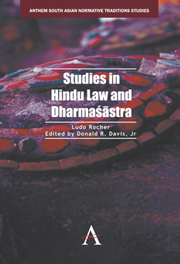Book contents
- Frontmatter
- Contents
- Foreword by Richard W. Lariviere
- Preface
- Abbreviations
- Note on the Edition
- Introduction
- PART ONE THE NATURE OF HINDU LAW
- PART TWO GENERAL TOPICS OF HINDU LAW
- PART THREE HINDU LEGAL PROCEDURE
- PART FOUR TECHNICAL STUDIES OF HINDU LAW
- Possession Held for Three Generations by Persons Related to the Owner
- The Vīramitrodaya on the Right of Private Defence
- The Technical Term Anubandha in Sanskrit Legal Literature
- The Kāmasūtra: Vātsyāyana's Attitude toward Dharma and Dharmaśāstra
- In Defense of Jīmūtavāhana
- Dāsadāsī
- The Definition of Vākparuṣya
- Janmasvatvavāda and Uparamasvatvavāda: The First Chapters on Inheritance in the Mitākṣarā and Dāyabhāga
- Karma and Rebirth in the Dharmaśāstras
- Notes on the Technical Term Sāhasa: “Fine, Pecuniary Penalty”
- Avyāvahārika Debts and Kautilya 3.1.1–11
- The Sūtras and Śāstras on the Eight Types of Marriage
- Caritraṃ Pustakaraṇe
- The Terms Niyukta, Aniyukta, and Niyoga in Sanskrit Legal Literature
- The Aurasa Son
- The Introduction of the Gautamadharmasūtra
- PART FIVE ANGLO-HINDU AND CUSTOMARY LAW
- Bibliography
- Index
Possession Held for Three Generations by Persons Related to the Owner
from PART FOUR - TECHNICAL STUDIES OF HINDU LAW
Published online by Cambridge University Press: 05 February 2013
- Frontmatter
- Contents
- Foreword by Richard W. Lariviere
- Preface
- Abbreviations
- Note on the Edition
- Introduction
- PART ONE THE NATURE OF HINDU LAW
- PART TWO GENERAL TOPICS OF HINDU LAW
- PART THREE HINDU LEGAL PROCEDURE
- PART FOUR TECHNICAL STUDIES OF HINDU LAW
- Possession Held for Three Generations by Persons Related to the Owner
- The Vīramitrodaya on the Right of Private Defence
- The Technical Term Anubandha in Sanskrit Legal Literature
- The Kāmasūtra: Vātsyāyana's Attitude toward Dharma and Dharmaśāstra
- In Defense of Jīmūtavāhana
- Dāsadāsī
- The Definition of Vākparuṣya
- Janmasvatvavāda and Uparamasvatvavāda: The First Chapters on Inheritance in the Mitākṣarā and Dāyabhāga
- Karma and Rebirth in the Dharmaśāstras
- Notes on the Technical Term Sāhasa: “Fine, Pecuniary Penalty”
- Avyāvahārika Debts and Kautilya 3.1.1–11
- The Sūtras and Śāstras on the Eight Types of Marriage
- Caritraṃ Pustakaraṇe
- The Terms Niyukta, Aniyukta, and Niyoga in Sanskrit Legal Literature
- The Aurasa Son
- The Introduction of the Gautamadharmasūtra
- PART FIVE ANGLO-HINDU AND CUSTOMARY LAW
- Bibliography
- Index
Summary
While a critical edition of the vyavahāra section of Gaṅgāditya's Smṛticintāmaṇi was being prepared, the following quotation of Bṛhaspati was found in the manuscripts:
bhuktis tripuruṣāt sidhyet pareṣāṃ nātra saṃśayaḥ ∣
anivṛtte sakulyatve sapiṇḑānāṃ na sidhyati ∣∣
A comparison of the variant readings given in both K.V. Rangaswami Aiyangar's edition of the BS (75) and the first volume of the Dharmakośa (414) shows that the Smṛticintāmaṇi is the only nibandha having the readings underlined above. The second half of the śloka generally runs as follows:
anivṛtte sapiṇ∣atve sakulyānāṃ na sidhyati ∣∣
Thus, the question arose whether it was possible to preserve the reading found in the manuscripts of the Smṛticintāmaṇi or not. Since the general principle which we have adopted for selecting readings provides that variant readings in the manuscripts should be preserved if they afford good sense, even if they differ from the readings found in all other sources, the problem was reduced to an enquiry into the sense of the reading of the manuscripts and at the same time, by way of comparison, into the meaning of the reading found in the other dharmanibandhas. In view of this principle, the reading of the manuscripts had to be rejected in favor of the generally accepted version; the meaning of the latter, however, presents some difficulties, and it is the purpose of this paper to seek to explain them.
- Type
- Chapter
- Information
- Studies in Hindu Law and Dharmasastra , pp. 445 - 450Publisher: Anthem PressPrint publication year: 2012



